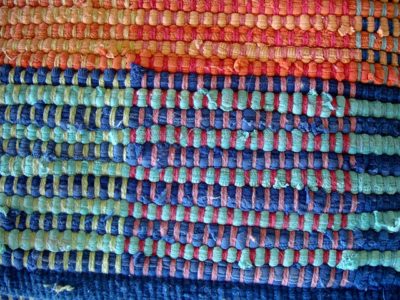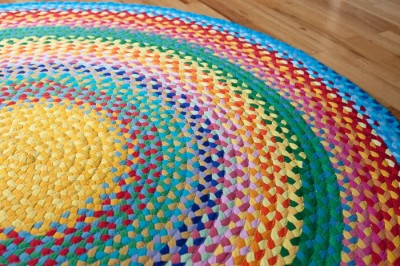To read part 2 in this series, click here.
Although it is simple to create a functional rug with purchased fabrics, it can be more resourceful and economical, and even more rewarding, if done with recycled materials.
Recycling worn clothing and other home fabrics may seem like a no-brainer, but in fact there are a few considerations to keep in mind.
Just as proper preparation and storage of your canned goods ensures a larder stuffed with what you need, organizing and caring for your recycled textiles means they will still be useful when you are ready to make something new. Choose your fabrics carefully, and store them properly, and you will be more successful in creating the final project according to your design.
Recycling and Storing Fabric
As clothing and other soft goods are worn out, stained, or otherwise taken out of commission in your household, you will need to establish a system for your recycling. Wash the garment, being certain it as is free of oils and odors as possible, and allow it to fully dry.
Discover More Than 1,000 Secrets For A Healthier, Safer Off-Grid Life!
Remove all buttons and other closures and save them — sorted by type in a button box is best. If you know you will not use a portion of the fabric, such as an embellishment, cut it off and discard it or save it in a sewing box for another purpose. Store the fabrics in mothproofed containers, such as a cedar chest, or plastic containers with tight fitting lids lined with cedar balls or lavender sachets.
 Store fabrics by type, thus making it easier to see if you have enough cloth for a specific project. Woven fabrics are characterized by threads that overlap in perpendicular lines, and are generally sturdier fabrics with little stretch. Knit fabrics have threads which interlock in loops, and are usually used in stretchy garments like T-shirts, jogging pants or sweaters. Of the two, woven fabrics will have the most applications in reuse, but knit fabrics can be used separately and are still worth preserving. Never mix woven and knit fabrics in rugs, as one has stretch and the other does not, and your rug will buckle and not lie flat.
Store fabrics by type, thus making it easier to see if you have enough cloth for a specific project. Woven fabrics are characterized by threads that overlap in perpendicular lines, and are generally sturdier fabrics with little stretch. Knit fabrics have threads which interlock in loops, and are usually used in stretchy garments like T-shirts, jogging pants or sweaters. Of the two, woven fabrics will have the most applications in reuse, but knit fabrics can be used separately and are still worth preserving. Never mix woven and knit fabrics in rugs, as one has stretch and the other does not, and your rug will buckle and not lie flat.
Read the original garment label to find the fiber composition of the fabric. Plant fibers like cotton, linen, hemp and bamboo are absorptive and can be hardwearing for rugs, especially in heavier woven fabrics like denim and canvas. Wool and mohair are part of a class of fiber known as animal fibers that also includes silk, alpaca, angora and cashmere.
Animal fibers each have their strengths, but wool reigns supreme for warmth and durability in rugs; the trouble is, wool clothing will wear out infrequently so you may have to wait a while. Synthetic fibers like acrylic and polyester are fine for outdoor use, although a small amount of synthetic fiber in a blend can add durability indoors, too.
Without A Doubt The Best Kept Secret In Indoor Self-Reliance Gardening…
One other thing to consider while storing fabrics is your ultimate design for the project. You may need a red rug, for example; in this case, sort your fabrics by type first and then by color, so you’ll know when you have enough of the color you need. Sentimental value is a way to sort, as well, as you can make a treasured heirloom from fabrics that hold special memories.
Preparing Fabric for Use
When you have enough fabric, spend several evenings preparing balls of fabric strips for the rug. Remove all seams and edges from the fabric, and cut strips about two inches wide, using the first strip you cut as a cutting guide. Cut strips along the grain of the fabric. Knitted fabrics will begin to unravel immediately after cutting, and will stretch a lot more in use, so you may want to cut them an inch or two wider. Fold each strip in thirds lengthwise, and sew it end to end with the last strip on a 45-degree angle, trimming off excess after sewing. For a more rustic look, you can knot strips together; however, this creates more waste and more bumps in your rug. As you attach new strips, roll a ball to store for your rug-making evenings.
Making rag balls is an excellent family activity; everyone old enough to operate scissors and needle can take part. It’s a great opportunity to spend time together and tell stories about the work that was done in the clothes, or the people that slept under the blankets, and to remind one another how you are working together to preserve your resources and add comfort and beauty into a room. Soon you will be ready to begin braiding or weaving the rug, and enjoying something not only made by you, but also saved by you—and you are sure to feel satisfied with each step!
Have you ever made a rug out of recycled fabric? What advice would you give someone? Share it in the section below:
Harness The Power Of Nature’s Most Remarkable Healer: Vinegar
 Off The Grid News Better Ideas For Off The Grid Living
Off The Grid News Better Ideas For Off The Grid Living





